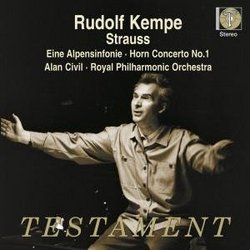| All Artists: Richard [1] Strauss, Rudolf Kempe, Royal Philharmonic Orchestra Title: Strauss: Eine Alpensinfonie; Horn Concerto No. 1 Members Wishing: 1 Total Copies: 0 Label: Testament UK Original Release Date: 1/1/2009 Re-Release Date: 2/10/2009 Album Type: Import Genre: Classical Styles: Forms & Genres, Concertos, Instruments, Brass, Symphonies Number of Discs: 1 SwapaCD Credits: 1 UPC: 749677142827 |
Search - Richard [1] Strauss, Rudolf Kempe, Royal Philharmonic Orchestra :: Strauss: Eine Alpensinfonie; Horn Concerto No. 1
 | Richard [1] Strauss, Rudolf Kempe, Royal Philharmonic Orchestra Strauss: Eine Alpensinfonie; Horn Concerto No. 1 Genre: Classical |
Larger Image |
CD DetailsSimilar CDs
|
CD ReviewsEXCELLENT, BUT KEMPE'S DRESDEN IS BETTER Mark E. Farrington | East Syracuse, NY | 11/06/2009 (4 out of 5 stars) "Those cumbersome indefinite and definite articles: when to use them and when not to use them?. What about letting the composer decide? So...EINE ALPENSINFONIE (AN ALPINE SYMPHONY) - not the "THE" ALPINE SYMPHONY...MESSIAH, not "THE" MESSIAH...SCHWANENGESANG and GOTTERDAMMERUNG, not "DIE" SCHWANENGESANG and "DIE" GOTTERDAMMERUNG. (Whatever.)
Strauss first began sketching this momumental work in 1900, and put it aside as he became occupied with his operas, from FEUERSNOT through DER ROSENKAVALIER. But in the spring of 1911, just after the wildly successful launching of ROSENKAVALIER, Strauss found himself in an unexpected lull as he awaited a new libretto from Hugo von Hofmannsthal (ARIADNE and FRAU OHNE SCHATTEN already being discussed). So, he resumed work on EINE ALPENSINFONIE; this was supposedly out of "boredom," but the REAL spur was the death of his friend Gustav Mahler, on May 18, 1911. Contrary to popular belief, EINE ALPENSINFONIE is, compositionally speaking, a pre-war work; the "particell" (piano-sketch) was actually completed in 1913. The orchestration was accomplished during another Hofmannsthal-induced lull in the winter of 1914-15 (as Strauss awaited the text to Act III of DIE FRAU OHNE SCHATTEN). He completed the massive score on February 8, 1915, and conducted the world premiere on October 28, 1915 in Berlin - not with the Berlin Philharmonic but with the Dresdeners, to whom the work was dedicated. EINE ALPENSINFONIE has an interesting recorded history...First, the 1920s set of Oskar Fried: yes, a primitive "acoustical" recording, but you are amazed that so much of the MUSIC actually got onto the grooves. And around the same time, in 1923, Fritz Reiner conducted his only known performance of EINE ALPENSINFONIE in New York's Lewissohn Stadium - and it was broadcast ! (What an exotic treat for those, within range, who had the "crystal sets" to pull it in.) Still, even if a recording was made AND it somehow survived, what could it possibly sound like? Anyhow, here is one of the most tantalizing what-ifs in classical recording history : a Reiner/Chicago/Living Stereo ALPENSINFONIE, because it COULD have been done. But the work itself was in such critical disrepute - especially in post-war America - and so very expensive to perform and record, that any commercial recording and promotion of EINE ALPENSINFONIE was, shall we say, "highly unlikely." Meanwhile, Richard Strauss himself made two recordings of it: in 1936 (although it had been lost until about 10 years ago) and in 1941 with the Bavarian State Orchestra (this was meant to be a soundtrack of a film that was never made). The sound is only so-so, but either may be the greatest surviving document of Strauss's genius as a conductor...Never mind what you have been told about the bland indifference of Strauss's latter-day performances, because both of these are white-hot, deep and supremely flowing. (For the Beecham-sponsored Strauss Festival in London in 1947, Strauss wanted to conduct EINE ALPENSINFONIE, but it proved too costly in those immediate post-war circumstances. Instead, he conducted his DON JUAN, BURLESKE and SYMPHONIA DOMESTICA.) But for a Hi-Fi commercial version (and, as it turned out, no so Hi-Fi at that), the record buying public had to wait until 1957 when Strauss's protegee, Karl Bohm, recorded it in Dresden. But even in DG's most recent CD transfer, the sound is still mediocre, not to mention that the Dresden wind playing leaves something to be desired - although the Waterfall episode is more scintillatingly conveyed here than in any other recording. Since Bohm never re-recorded EINE ALPENSINFONIE in stereo, here is another Straussian might-have-been, because this is a truly great, cohesive performance of almost Brucknerian breadth and depth. Bohm's tempi are slower than with Strauss, Fried, Kempe, Solti and Karajan, but the sense of spaciousness almost ovecomes the limited sound and faulty playing. So, for Straussians, it was a keenly anticipated event when, circa 1964, Rudolf Kempe and the RPO recorded the first commerical, stereo ALPENSINFONIE. In America it was released by RCA. Its beautiful cover, a Tyrolean green-bordered Kodachrome of the glacially-capped Matterhorn, was criticized as misleading; because scaling such a peak would certainly take longer than the one-day journey evoked by Strauss's music. (Mount Marcy or Mount Washington might be more fitting.) But this superbly recorded performance WAS a revelation. The RPO's playing is certainly not faultless, but still a vast improvement over the playing on Bohm's Dresden LP. There is also a sense of freshness and discovery in the RPO's playing - and for good reason, because at the time (outside of, say, Munich and Dresden), EINE ALPENSINFONIE was NOT in the mainline orchestral repetoire. Kempe re-recorded EINE ALPENSINFONIE in 1971 in Dresden, and IMHO this ranks as the premiere stereo interpretation of the work. Not only does the orchestra play the work far better than they did for Bohm 14 years previously, but Kempe guides and moulds the music even more masterfully than he had for his RPO recording. True, he had lacked Bohm's advantage of going over scores with Strauss, one-on-one ; still, in 1929, as the 17-year old first-chair oboe in the Leipzig Gewundhaus, he had played this work under Strauss's direction. Such is the collective spiritual grasp of this music, on the part of Kempe and the Dresdeners, that you may find yourself forgetting that this work, scored for a 120-piece orchestra - complete with off-stage horn ensembles, plus thunder-and-wind-machine - is often dismissed as a musical curio of bombastic, Wilhelmian Germany. (To call anyone's bluff, the Kaiser would have been COMPLETELY out of this depth, had he attempted to sit through this work. After all, for him, even the popular ROSENKAVALIER was "kein Musik fur mich." ) As in Strauss's later "Bucolic Tragedy" DAPHNE, the quieter passages of EINE ALPENSINFONIE emit an almost Brucknerian contemplation of which his enemies have always insisted he was incapable - due, in part, to his "failure" to consistantly traffic in conscious, "Beethovenian" profundity. But with no HELDENLEBEN-ish "mind" to his opponents, Strauss simply ROUTS them. Even the "louder" moments, such as the Summit (as Michael Kennedy so presciently points out) are not quite what they seem : only half the orchestra actually plays this most "monumental" passage ! No matter what the moment calls for : large forces (120 players, including off-stage brass for mountainous "echo" effects", plus the infamous thunder and wind machines for the Storm sequence); small forces (pared down, at one point, to a string quartet); in-between forces (i.e., at the Summit); or shifts between all three : it is all done in the service of MUSIC, not surface effect. (This is hardly the 'Wilhemian Way'.) Dresden was the premiere city for 9 of Strauss's 15 operas, and since the early 20th century nearly all of them have been constantly in and out of the repetoire. Not only that, but (as I have written elsewhere) well into the 1970s this orchestra still retained players who had been conducted by Strauss himself. (Strauss frequently apppeared and guest-conducted in Dresden, until his last visit there in October 1944, during the festivities honoring his 80th birthday.) But think of all that sheer CHARACTERIZATION and intimate familiarity with Strauss's musical language, applied to such a "tough nut to crack" as EINE ALPENSINFONIE - and then you may begin to sense the sheer APTNESS of this performance. Kempe's Dresden ALPENSINFONIE was once available singly as an Audio DVD but now, to have it, you must obtain Kempe's complete Dresden boxed on EMI. (See my review.) Still, for what it offers (9 discs of mostly top-drawer, and sometimes rare, Strauss) and for its price, not even a casual Straussian should be without it. Bottom line: (1) The Dresdeners had the warp-and-woof of Strauss's tricky music IN THEIR BLOOD AND BONES, as no orchestra has - or may ever have again. (2) At the helm was Kempe, one of the four or five true masters of Strauss's overall output. (3) It was all captured in spacious Hi-Fi Stereo. So, for truly authentic, Straussian feeling AND in Hi-Fi stereo, this, in my humble opinion, is "THE" (oops) ALPINE SYMPHONY." |



![Icon: Hans Hotter, the Great Bass-Baritone [Box Set]](https://nationalbookswap.com/cd//m/48/5648/6185648.jpg)